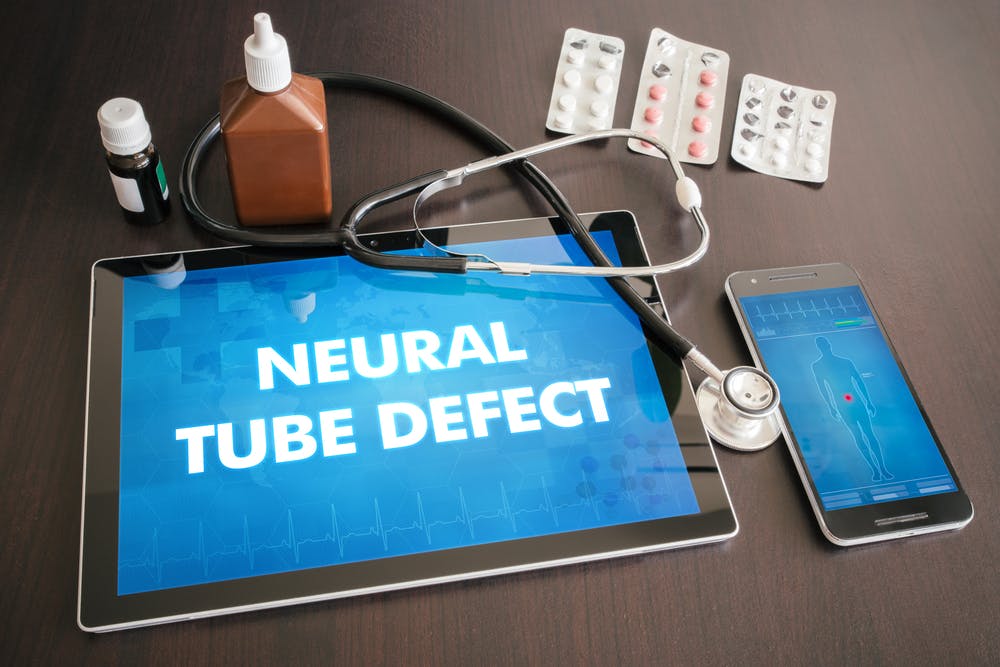Fetal neural tube defects are the second most common congenital malformations that affect the central nervous system. These occur when the early fetal brain and spine (the neural tube) do not develop and close properly during development. Neural tube defects in pregnancy occur very early in the first trimester — sometimes before a woman even knows she is pregnant.
The Most Common Neural Defects
Two of the most common neural tube defects in pregnancy are spina bifida and anencephaly. Spina bifida is a defect of the fetal spine. This occurs when the developing bones of the spine don't close correctly around the spinal cord, which results in damage to the cord and nerves.
Myelomeningocele is the most serious kind of fetal neural tube defect, where a fluid-filled sac develops on the fetal back at the location where the spinal bones did not close properly. This sac contains part of the spinal cord and nerves, and damage to these can lead to moderate to severe physical disabilities. A meningocele occurs when a fluid-filled sac develops on the fetal back, but the spinal cord is not pulled into this sac. This results in very little to no nerve damage and results in only minor disabilities.
Anencephaly is a type of neural tube defect that occurs when the upper part of the neural tube does not close all the way, so the forebrain and cerebrum do not develop. Large parts of the fetal skull and brain are absent, and some of the brain tissue that does develop is not covered by bone or skin and can become damaged due to lack of proper protection.
Ultrasound Provides Early Diagnosis
Ultrasound is commonly used to detect and diagnose neural tube defects. Some types of fetal neural tube defects are more readily visible in the first trimester, such as absence of the cranium in anencephaly. The more severe the defect, the more readily apparent it can be found on ultrasound. Other signs visible prior to 24 weeks gestational age are the "lemon sign" of the cranial bones, visible in 98% of spina bifida cases, and the "banana sign" of the cerebellum, visible in 96% of these cases. These changes to the fetal skull and brain are thought to be a result of brain displacement due to the abnormal location of the neural tube caudally.
A new first-trimester sonographic finding for open spina bifida has been recently discovered, allowing for even earlier diagnosis of neural tube defects in pregnancy. During the 11-13 week obstetrical ultrasound exam, a mid-sagittal view of the fetal profile reveals that the fourth ventricle of the brain is visible in the normal fetus. However, in cases of spina bifida, this fourth ventricle is not visible as it has been compressed due to the caudal displacement of the neural tube.
Other sonographic markers of neural tube defects are being proposed and explored as well, such as decreased frontomaxillary facial angle, brainstem diameter and brainstem-to-occipital-bone distance.
Treatment and Prevention
Treatment options vary widely for neural tube defects. Anencephaly does not have any treatment options. There is no known cure for this defect, and these infants almost always die shortly after birth. However, spina bifida defects, which range from very severe to very mild, do have surgical options for closure and repair of the affected area of the spine.
The most effective treatment option known so far is prevention. It has been shown that the risk of fetal neural tube defects developing can be reduced by up to 70% when a woman consumes 400 micrograms of folic acid and a multivitamin with B vitamin folic acid before and during the first three months of pregnancy.
What Makes This Condition So Complicated?
Because neural tube defects vary so widely in their presentation and effects, this condition can be complicated to diagnose and treat. Ultrasound is one of the most reliable imaging methods used during pregnancy as it allows for the earliest detailed assessment without any risk to the fetus. As the technology evolves, image resolution will improve and abnormalities like these can be diagnosed earlier, allowing for the best possible treatment and outcome for both parent and infant.





